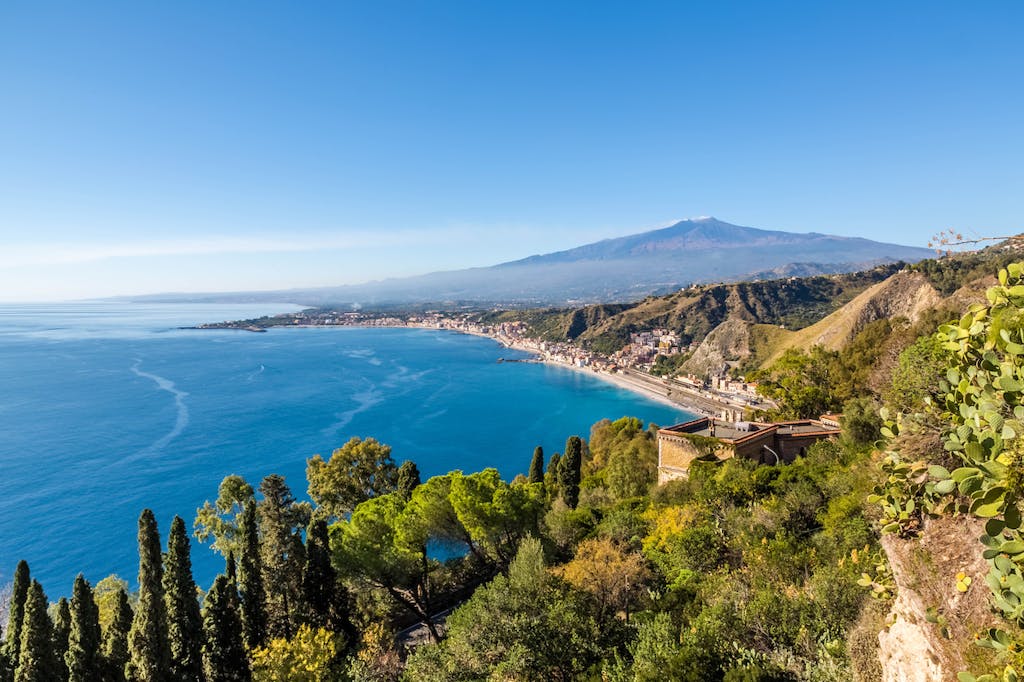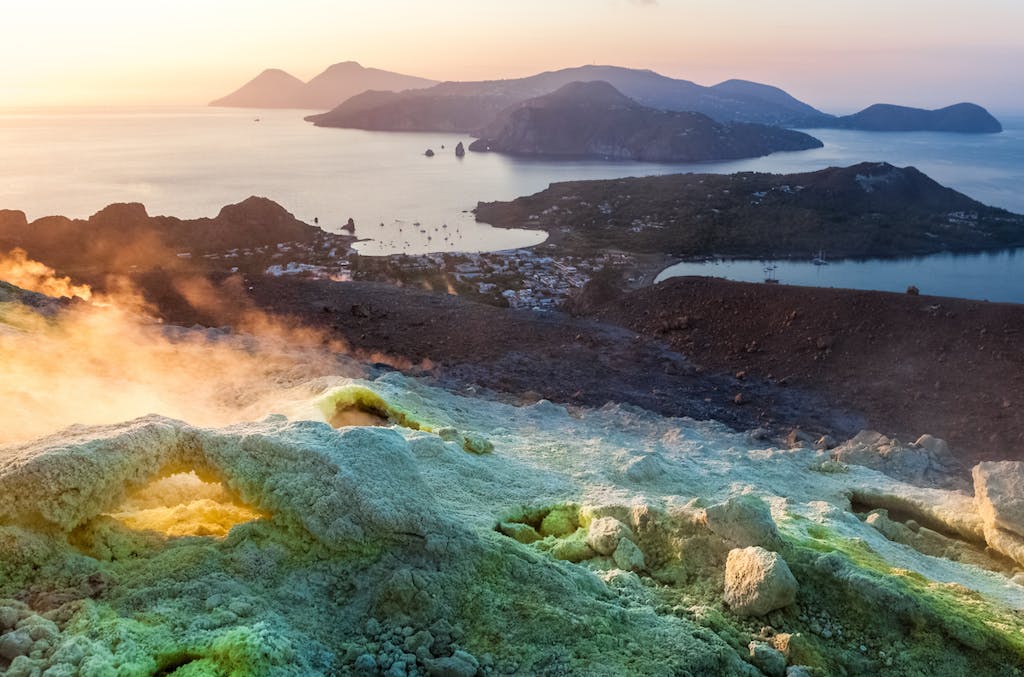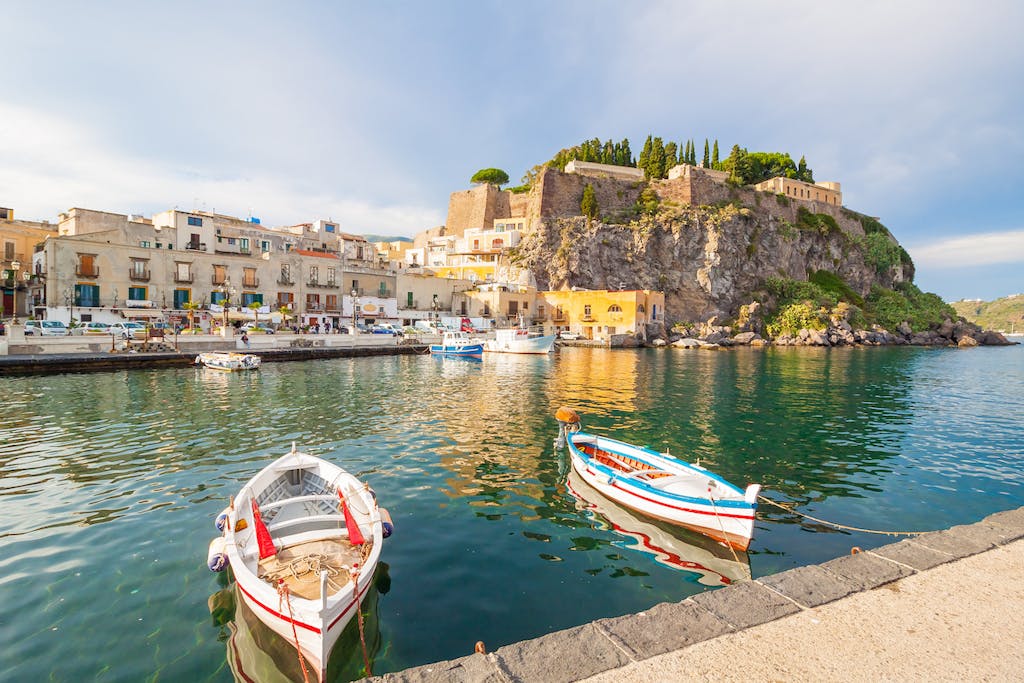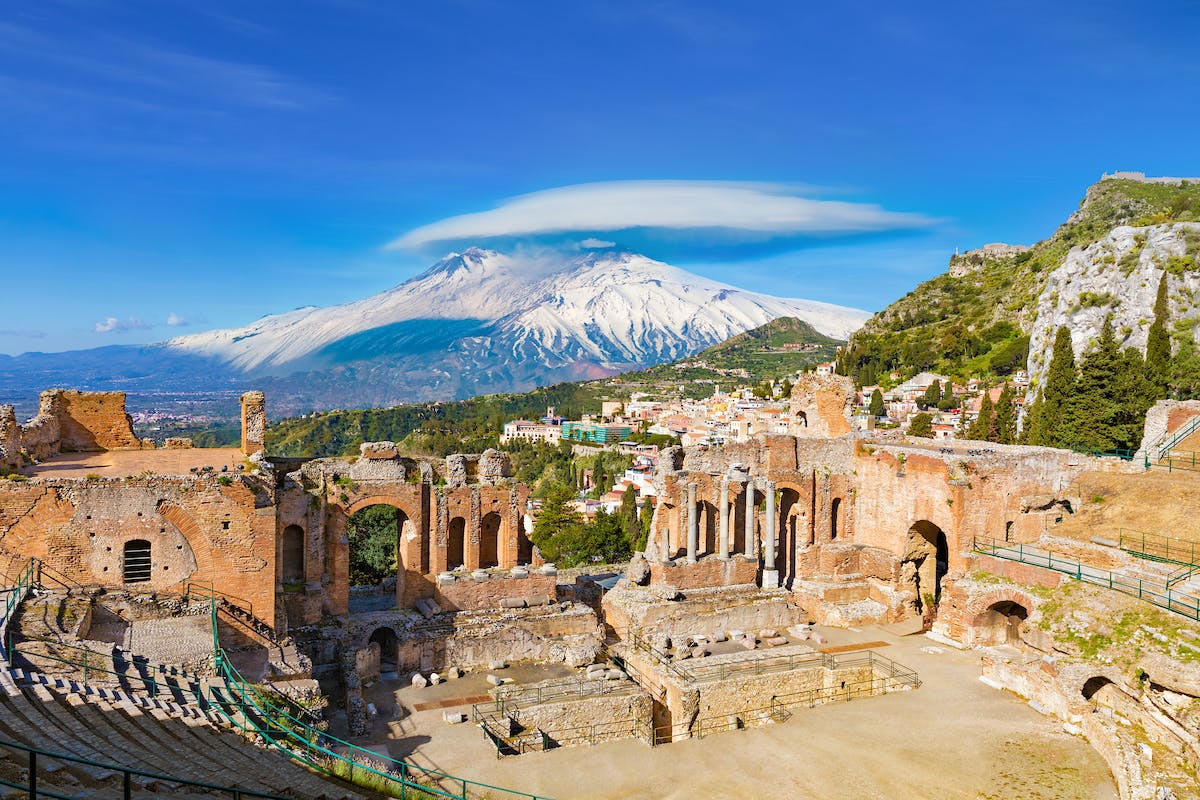Enjoy a Unique Adventure: Touring the Active Volcanoes of Italy
I confess: I have a volcano fixation.
As a nine-year-old, I slept nervously in a camper van rather than the family tent while on a camping trip to Lassen Volcanic National Park in California. I wanted to be ready for a midnight escape should the volcano decide to replay its explosive eruption of 1915. Lassen Peak stayed quiet that night, as it has for a century now, but that view from the campsite towards the imposing silhouette of the mountain, framed by a million stars, has never left me.
My travels since then have taken me to active and dormant volcanoes around the world, lured again and again to as near as I could safely approach them. The smoldering summits of Mount St. Helens in Washington, Montserrat’s Soufrière Hills, Piton de la Fournaise of La Réunion and, of course, those feisty Hawaii volcanoes, are all stamps for my lava-loving passport.
In Europe, it is Italy I return to, because the country is home to the continent’s major volcanoes. And because, well… it’s Italy. Over the years I have managed to set foot atop the country’s four most notorious summits, each of them possessing a link to history and mythology. Most famous, of course, is Vesuvius, the mountain that rained a torrent of boiling debris down on Pompeii and nearby Herculaneum, burying them for future explorers to discover.

Having reveled in the ruined cities multiple times, on my last cruise calling on Sorrento I boarded the Circumvesuviana Train for Ercolano. A local bus climbed the scenic, winding road past cinder cones and the lava flows from Vesuvius’ last eruption in 1944. A car park at the 1,000-meter elevation accesses the steep, mile-long trail that spirals up the barren slope to the rim of the Gran Cono.
The gaping summit maw is awesome, ringed by outcrops of jagged lava, seasoned by wisps of steam from fumaroles. Selfies are paramount, but a camera just doesn’t do justice to the summit’s CinemaScope view. Another trail follows the rim to a high point, and from here I can spot Pompeii way, way down the slopes. The distance — six miles as the crow flies — underscores the power of Mount Vesuvius’ AD 79 eruption.
As the most heavily populated volcanic region of the world, scientists dedicate careful attention to Vesuvius. A serious eruption would potentially require evacuation of as many as 1 million people living just in the immediate surrounding area. The permanent threat to cities in close proximity has been leavened for 2,000 years by the fertile landscapes the volcano has produced, allowing vineyards and orchards to thrive.
That, and who wouldn’t want to live amid the sweeping panorama of the Bay of Naples?
The Sicilian Giant
But Vesuvius has competition for the title of Europe’s grandest volcano. Dominating the horizon of Sicily from land and sea, Mount Etna is one of the world’s most active volcanoes. But despite its prodigious activity, a road snakes close to the summit of this 11,055-foot beauty, making it a prime target for volcano-baggers. And so, one June morning, I landed in Catania, hoping to gain a better view of Mount Etna during a period of relatively quiet activity. I arranged to meet up with a professor from the local office of Italy’s Institute of Volcanology. He was headed to the summit with a photographer to document the current activity and I was more than happy to tag along.
The city of Catania sits 18 miles from Etna’s crown — close enough that, in 1669, slow-moving lava flows just breached the city walls and surrounded the Castello Ursino before entering the Ionian Sea. For many years lava from this eruption was used to pave roads and for building foundations. Although lava remnants weren’t obvious to me when I arrived, the charming Fountain of the Elephant — Catania’s icon — was carved in 1736 from lava. During the ensuing centuries, eruptions have been limited to Etna’s upper slopes, but residents of many villages on its flanks have intervened when lava neared, sometimes successfully redirecting the flow with sheer muscle; more often, the very devout Sicilians have resorted to religious services, with mixed success.

I met the professor and photographer in the town of San Giovanni, and following a refreshing latte di mandorla — sweetened almond milk — we headed up the mountain, passing groves of orange, lemon, and olive trees. As with Vesuvius, Etna blesses the surrounding territory with rich soil; blood oranges and Bronte pistachios, apiaries worked by Sicilian black bees, and vineyards that tap the savory minerals of its ashen flanks.
Reaching the idle ski lifts at Piano Provenzana, we pulled over so I could survey the tourist tchotchkes for sale — eruption videos, Virgin Marys and Christs made from ash, and a local liqueur, fuoco dell’Etna. One sniff of the raspberry-colored fire water and I knew it’s not what I needed at 10 in the morning. The scientist urged me back into the jeep to ascend a steep, 4WD trail which snaked through old lava flows, sharp and crinkly in alternating colors of chocolate and licorice. In the distance was a cinder cone, and a column of steam pirouetted into the clouds, but that was not our target today.
Still, right here, Etna’s activity is unmistakable: A chunky river of black flowed across the landscape, inching forward at a barely discernible pace. As the photographer snapped away, the professor lured me closer to the creeping lava and I could see the red-orange glow between shifting cracks in the flow’s surface. The scene is so benign, it’s hard to reconcile it with the mile-high fountains Etna has been known to produce. And yet, this quiet encounter, within kissing distance of searing lava from one of the world’s great volcanoes, is totally satisfying.
Vulcan’s Workshop
The day after my Etna encounter I ferried to the Aeolian Islands, a volcanic archipelago of seven inhabited islands sitting just off Sicily’s northeastern coast. Five of this septet have been quiet for many lifetimes, but two wear their activity quite visibly. Lipari is the hub of these beauties, but I zipped over to nearby Vulcano, less than a mile away, where Gran Cratere looms over Porto di Levante. At the edge of town, shallow pits contain the island’s celebrated fanghi, ostensibly therapeutic mud. On this day, more than two dozen bathers have slid into the steaming elixir and slathered their bodies.
Unfortunately, the mud reeks of rotten eggs — sulfur’s signature fragrance — though the mostly older bathers don’t seem to notice, scooping deep for the thickest of it to smear on their face and even hair, where it dries into a powdery crinkle. Nor do they seem to mind that their bathtub sits atop a restless geological hot spot.

Although hulking Gran Cratere is hardly the most dramatic-looking volcano one could seek, it boasts an important pedigree: It’s the mythical workshop of Vulcan, Roman god of fire. How could I resist a one-hour hike to the front door of his office? Scrabbling up the signposted path I notice wisps of steam coming off the rim above.
Alas, for those who might expect a glowing, clanking metallurgical factory, cresting the crater wall and peering in yields nothing more spectacular than a bowl-shaped landscape of — you guessed it — mud. But steaming vents along the northern rim are a sulfurous fantasyland: rocks stained a Day-Glo yellow, fringed by tiny crystals that sparkle in the sunlight. I moved in closer for photos but the fumes seared my lungs — better to enjoy these sights out of range of the gas.
Down the outer slope, the homes of Porto di Levante sit placidly, and appallingly close — about 1,000 people live on the small island. Vulcano has not had an eruption since 1890, but scientists keep an eye on the ill-tempered temple and warn that a modern catastrophe is possible.

The Lighthouse of the Mediterranean
Still, I wanted more tangible evidence of Vulcan’s presence, so I signed up for a day trip to nearby Stromboli — the island that gave its name to describe a particularly accessible type of eruption: Strombolian.
The volcano has a storied history. In Jules Verne’s “Journey to the Centre of the Earth,” a crew of raft-bound explorers rockets back to terra firma via Stromboli, by tickling the volcano’s throat with a blast of gunpowder and being coughed to the surface atop a river of magmatic phlegm. Fortunately, my journey to the mouth of Stromboli would be a little less traumatic, though approaching the island by afternoon speedboat from Lipari was still exhilarating.
Barely two miles wide, yet soaring to a height of 3,031 feet, the entire island is the volcano, and vice versa. The clouds of steam hovering at the summit were flustered by faint eruptions every 20 minutes or so, swirling the white crown into fanciful plumes. Stromboli’s severe northern slope was a featureless carpet of ebony. Assaulted by lava bombs through the day, the Sciara del Fuoco — trail of fire — becomes a glowing waterfall of orange and red at night.
Stromboli’s nickname: Lighthouse of the Mediterranean.
We swing around to land at Stromboli’s main village, San Vincenzo, and were led to a church that sits above the hamlet. In front of the nave, each evening a flock of visitors gathers for a guided hike to the summit. Residents pay scant attention to the small crowd — motorbikes buzz through the tiny piazza every few minutes, while older islanders trade gossip. Just before 5 p.m., our shoes were inspected to verify they were sturdy enough for the rugged terrain, and we are provided a flashlight and bamboo walking stick. Our guide, from the Italian Alpine Club, wore an easy smile, natty hiking garb, and a two-way radio to exchange any potential updates on the activity, and tells us that we would be limited to one hour on top. Handing out hard hats, he says, “You are all going to have to bring one to wear at the top, in case the volcano decides to become active.”

The route to the summit started up a narrow road through the village, passing a pink house where Ingrid Bergman conducted a notorious affair with Roberto Rossellini in 1949, during the filming of “Stromboli.” Along the road, capers and artichokes were just beginning to flower, while crimson and violet bougainvillea hugged whitewashed walls that wrapped around backyard vineyards. Our group, which numbered about two dozen, percolated in a cacophony of languages as the path ascended the gentle slope beyond the village. When we reached the base of the grim Sciara del Fuoco, the trail made an abrupt turn to climb a steep, brush-covered shoulder.
Conversations dissolved into labored gasps as we negotiated the rocky trail. High above, the volcano fumed.
Two hours later, near the top of this ridge, the crater came into view, but rather than scary, the sight was quixotic. The curls of steam whispered around its lips were painted in peach tones — the last remnants of the setting sun. And unlike the yawning mouth of Vulcano, Stromboli’s vent was little more than a pip-squeak hole just below the mountain’s highest point. But just as I was about to discount Stromboli as a wanna-be, the chasm convulsed and spewed like a Roman candle. The display lasted just a few seconds, but I stood in wonder as incandescent rocks vaulted into the air.
As if on cue, everyone put their helmets on.
A few hundred yards further we crested the mountain, glaring anxiously into the crater below. A swirl of vapor engulfed us, obscuring the orifice. I sat down on a rock, knotting fingers that had become numb by the cold, and waited for another explosion. And waited. Old Faithful this wasn’t.
“How often do the eruptions happen?” asked one young hiker. Our guide shrugged his shoulders and told us that sometimes the volcano takes the night off. As the sky darkened to an inky black I started to think that perhaps we’d seen all Stromboli had to offer. An hour passed and our guide gathered his reluctant group together for the descent, prodding us to head down the ashy slope.
Suddenly, the thud of a cannon stirred the night. I spun around just in time to see the steam light up from inside and fireworks shoot skyward. We all cheered. Vulcan had apparently been on an espresso break.
